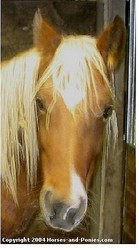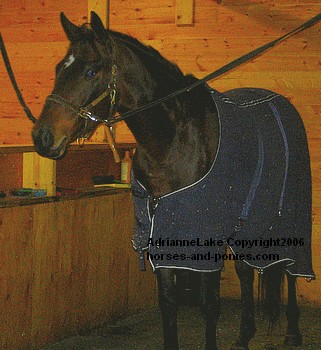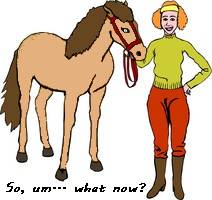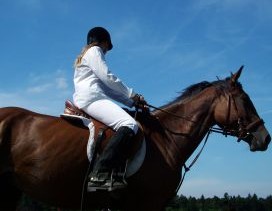What to Expect in Your First Riding Lesson
 In this article for beginning riders, you will learn about what might be expected of you during your first riding lesson and how to cope with this exciting, new experience of riding a horse.
In this article for beginning riders, you will learn about what might be expected of you during your first riding lesson and how to cope with this exciting, new experience of riding a horse.
What to Expect When At Your First Riding Lesson at a Stable
When their first riding lesson is nearly at hand, students often wonder what type of horse they will get and what they will be expected to accomplish. It’s understandable that some students have anxiety as they wonder what to expect.
Most students worry particularly about their intended mount; so, keep in mind that at respected riding schools, school horses are often characterized into groups based on their appropriateness for riding levels. Beginner riders will often be assigned the aged, semi-retired, easy going, forgiving lesson horse whose only vice may be his pokiness. Knowing that a beginner will have little control over her hands or feet and may flop around in the saddle, the ride school will provide a safe horse for her level.
When you arrive, the school will likely ask to check your helmet to ensure that it is ASTM/SEI certified for horseback riding. If it is not or it is not a horseback riding helmet, you will need to borrow one from the ride school.

As you move about the premises, be courteous to fellow horseman. That means, no running or sudden movements near horses being handled or ridden. Leave your dog at home as barking can upset some horses. Turn your cell phone to vibrate or off. Understand that some horses are sensitive to flash photography, so before taking any pictures, ask the instructor. For parents bringing other children, there is to be no running around the horses at any time. Also note that some horses spook at strollers, so alert the barn if you intend to bring one.
Most likely, the instructor will accompany the student into the barn to get the mount. Younger children need to be reminded that they must act like a guest in someone’s house and don’t touch anything unless they ask first and to use their indoor voices. There is to be no running or yelling in a barn. Following are some guidelines to remember on your first visit to the barn:
Entering the Stall
Do not enter the stall if the horse has his tail to you. You are to enter the stall only when the horse is facing you. Do not enter the stall until the instructor tells you to do so.
Leading Your Horse from the Stall
Most facilities have the beginner horse tacked and ready to go prior to the lesson. So, you should be able to lead the horse from his stall. Before leading the horse into the aisle of the barn, call “heads up” so you don’t come crashing into someone else going down the aisle.
For small children leading horses, some facilities will ask that you keep the reins over the horse’s neck. This is because small children may let go of the horse, and if they do, there’s less of a chance the horse will step on the reins.
For older children and beginner adults, you may be allowed to take the reins over the horse’s  head and lead him with the reins held in both hands-right hand under the chin and rest of the reins going to the left hand at your left side. Check with the facility as to how they prefer the horses led.
head and lead him with the reins held in both hands-right hand under the chin and rest of the reins going to the left hand at your left side. Check with the facility as to how they prefer the horses led.
Leading Your Horse to the Arena
Hold your horse directly under his chin in your right hand. By holding further back on the reins, the horse can turn and bite you. (Not that he would, but for safety’s sake, we’ll hold him the safest way.) Hold your arm straight out to him so that both you and he have your own separate paths, and he won’t accidentally step on you.
Entering the Arena
When you enter the arena, you typically lead your horse into the center of the arena and turn and face him toward the in-gate. Horses should face the in-gate so they aren’t surprised by other horses coming in and can see them approaching or other things going on around the arena entrance.
Mounting
Don’t get on the horse until your instructor tells you to and helps you. The first thing you and your instructor must do is check the equipment to ensure it is on correctly and safe for you and the horse. The instructor will check the saddle pad to make sure it is protecting the horse’s back. She will also check the girth to make sure it is tight enough that the saddle doesn’t slip when you mount. She will also check the girth again when you are mounted, especially if you’re using a very thick saddle pad. The instructor will check the bridle to make sure all the leather parts are in the right spot and secured.
Your instructor may give you a leg up or have you mount from a mounting block. Either way, you will be mounting the horse on his left side. You will take the reins in your left hand, grab a lock of main in the hand. Using your right hand to hold the left stirrup, place your left foot into the left stirrup. Then take hold of the cantle (the back of the saddle) with your right hand and swing your right leg over to the right side without hitting his
hindquarters with your foot. Try not to come flopping down on his back and sit softly and quietly. (It’s hard to do
your first few times, but try!)
Your instructor will then adjust your stirrups.
The Lesson
For your first lesson, your horse may be placed on a longe (pronounced “lunge”) line. The line is handled by your instructor and keeps your horse on a circle around her so she can control where he goes and talk to you.
Your instructor will go over the basics of the proper seat:
(Photo courtesy of Mirek Molin of the Czech Republic).
Sitting – like you’re standing n ext to the horse with bent knees, not like you’re sitting in a chair all the way back on your butt. Sit on your seat bones. Straight back-by lifting from the base of your sternum and allowing your shoulders to stay back. Not roaching the base of your back and not forcing your back to arch unnaturally.
ext to the horse with bent knees, not like you’re sitting in a chair all the way back on your butt. Sit on your seat bones. Straight back-by lifting from the base of your sternum and allowing your shoulders to stay back. Not roaching the base of your back and not forcing your back to arch unnaturally.
Legs – Leg beneath you – not pushed out in front. Your heel should fall nearly under the bend in your knee. Your calf is slightly behind the girth and in contact with the horse’s side. Heel-flexed down, allowing your weight to drop down into your heel. The stirrup iron should be on the ball of your foot.
Hands – holding the reins. Hold your hands like fists with thumbs facing up. The reins will run either: through the bottom of your fist, out the top under your thumb or in through the ring and pinkie fingers and out through the top under your thumb. Hands should be over the horse’s withers (his shoulder) and angled to the angle of the shoulder (in between thumbs up and angled slightly toward each other.) Hands are held slightly apart from each other and are to make a straight line through the reins to the bit in the horse’s mouth.
Head: Head-up and eyes looking ahead.
In your first lesson, you will be taught how to make the horse walk. You will also be taught how to make him turn and stop. You may even get to trot in your first lesson! And, if you trot, your instructor may start teaching you how to post (if riding English). At the end, you’ll be taught to dismount by taking both feet out of your stirrups and swinging your right leg around his back and sliding down the left side. Or your instructor may teach you to “kick free” in dismounting by keeping your left foot in the stirrup until you swing your right leg over, then kicking free your left foot of the stirrup then jumping down to the left side. Regardless of how you are taught to dismount, you will always do so facing the horse and off the same side that you mounted from – the left.
That’s all you will likely do in your first lesson. It may not sound like a lot, but you will be spending a bit of time just getting used to balancing on a horse, maintaining and correcting your position, keeping with his rhythm and basically getting a feel for where your hands, feet and legs are. It will be a lot to think about, and you’ll probably be tired afterward.
Good luck with your first ride and happy trails!
About the Author: Buying or Selling a Horse – We are your only Resource https://www.theequineyard.com/network.php